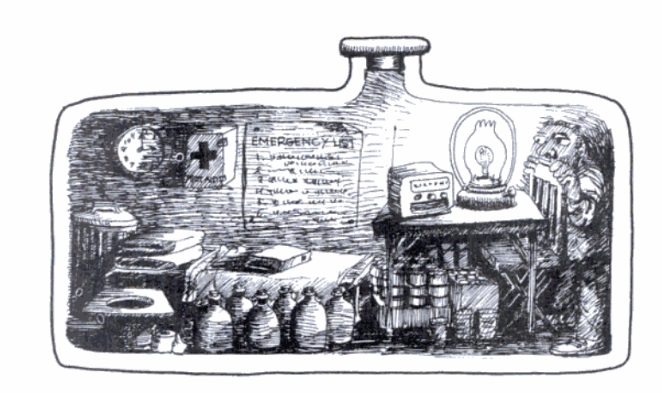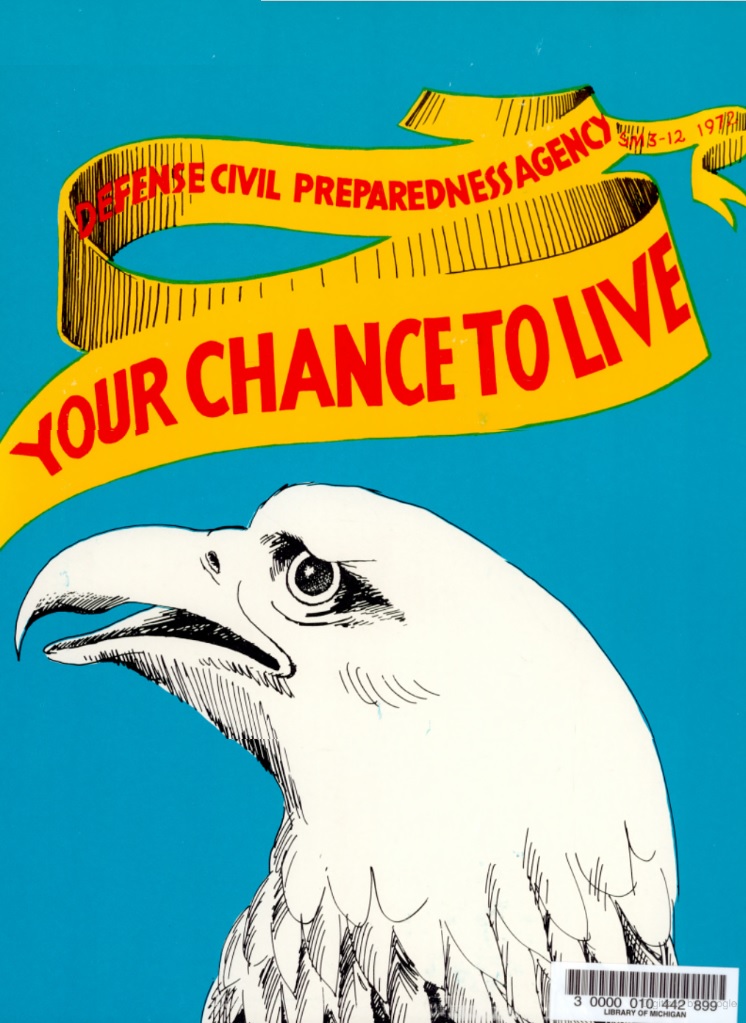
On my way to looking up something else, I was shocked to discover that this book, of over a hundred pages, existed. It was published 50 years ago by the Defense Civil Preparedness Agency, as the federal Civil Defense agency was known at the time. I was the target audience of this book, I would have loved it, but I didn’t know it existed.
One day as a youth, I discovered in our basement a Civil Defense pamphlet (specificaly, “In Time Of Emergency,” and I found it absolutely fascinating. The second half of the book, entitled “Natural Disasters,” covered things I was more or less familiar with, namely, floods, hurricanes, tornadoes, winter storms, and earthquakes. But the first half of the book was something entirely new, namely, something called a Nuclear Attack.
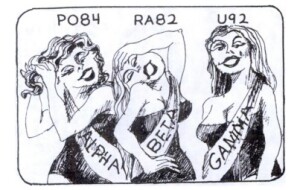 I was aware of the concept of war, and I was even aware that the bad guys might drop bombs during a war. But the bombs described in this book did more, namely, unleash radioactive fallout. And to survive a nuclear attack, you had to have a fallout shelter. For some reason, my parents were unwilling to construct a fallout shelter, but based upon the material in the book, I knew that we could eek by either with an improvised fallout shelter, or by going to the public fallout shelter across the street at the school I attended (although I had some doubts as to whether someone would come around to unlock the building if the nuclear attack took place other than during school hours).
I was aware of the concept of war, and I was even aware that the bad guys might drop bombs during a war. But the bombs described in this book did more, namely, unleash radioactive fallout. And to survive a nuclear attack, you had to have a fallout shelter. For some reason, my parents were unwilling to construct a fallout shelter, but based upon the material in the book, I knew that we could eek by either with an improvised fallout shelter, or by going to the public fallout shelter across the street at the school I attended (although I had some doubts as to whether someone would come around to unlock the building if the nuclear attack took place other than during school hours).
In general, I became an advocate for everything I learned from the little book, and I though everyone should begin making some minimal preparations for, or at least having some awareness of the risk of, one of these nuclear attacks, as well as the other disasters described in the booklet.
Much to my surprise, most people seemed to dismiss my concerns, and some of them even seemed to actively avoid making even the most minimal of preparations. I couldn’t quite understand this attitude (in fact, I still don’t understand it). But I did do my best to promote civil defense. And since I was in school, the school provided me with my principal forum for my efforts. Of course, my poor sainted sixth grade teacher took the brunt of this, since she got to listen to me talk about civil defense whenever I could possibly work it into the conversation.
I learned all I could about civil defense, including getting every last piece of literature available from the local civil defense office. I also went to the public library, where I found what were possibly the only two books on the subject, namely, the novel Alas Babylon by Pat Frank, and his non-fiction work, How To Survive the H-Bomb and Why.
Frankly, I thought having a fallout shelter would be pretty cool. But it seemed that I was the only kid thinking this, and I eventually figured out that I was the only person–child or adult–with any interest in civil defense and fallout shelters.
It wasn’t until many years later that I discovered that there were other kids like me. It turns out that Alas Babylon is still in print and became something of a cult classic, and copies of How to Survive the H-Bomb and Why now go for hundreds of dollars, if you can find them.
And unbeknownst to me, somewhere in the Pentagon, someone was trying to help me in my quest to educate American students about the importance of civil defense. The book depicted above, “Your Chance to Live” was in production by the Defense Civil Preparedness Agency, and it was intended as a textbook for students on the subject of civil defense. Had I been aware of such a book at the time, I’m sure I would have pleaded with my teacher to get some copies, and if she balked, I probably would have appealed to the principal and then to the Board of Education. In fact, I would have gladly taken over the teaching duties as my classmates learned the lessons from this book.
The book is now available on Google Books, along with the teacher’s edition, and the accompanying “Games that Teach: Classroom Activities on Individual and Community Disaster.” While the exact grade level of the book isn’t entirely clear, the latter two books make clear that it is suitable for all grades, from 1 through 12.
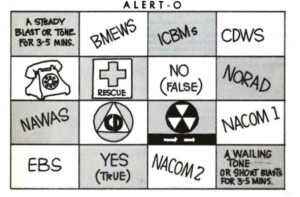 The activities are particularly interesting. One of them, shown at left, is an ALERT-O card, similar to BINGO. In this fun activity, suitable for grades 5-12, each student would be given an ALERT-O card, and the teacher would call out items from the card, such as “Intercontinental Ballistic Missile.” Students would mark the appropriate spot on their card, and the first student with four in a row would be the winner.
The activities are particularly interesting. One of them, shown at left, is an ALERT-O card, similar to BINGO. In this fun activity, suitable for grades 5-12, each student would be given an ALERT-O card, and the teacher would call out items from the card, such as “Intercontinental Ballistic Missile.” Students would mark the appropriate spot on their card, and the first student with four in a row would be the winner.
The telephone was the response to “do not use this to obtain further information and advice about an emergency,” and there were two True-False questions. The guide noted that after the game was played, students would probably have questions, which could lead to further research on topics of interest. For example, one student or a group might be assigned to do a research report on NORAD.
The book was full of other games and activities about civil defense. For example, in one activity, a group of students would bring together items necessary to stock the fallout shelter, and then discussing the relative merit of the selected items. There were even crossword puzzles (for grades 7-12) with words such as “nuclear” and “bomb.”
Even younger students could join in on the fun activities, such as the color-by-number puzzle at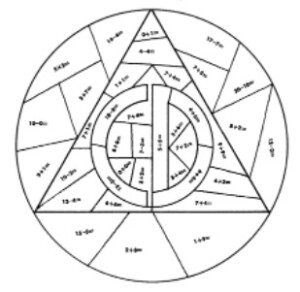 the right. In addition to familiarizing students with the CD emblem, it would help them brush up on their math facts.
the right. In addition to familiarizing students with the CD emblem, it would help them brush up on their math facts.
The textbook itself is fascinating. There are a few blanks that the student is directed to fill in with local information, such as the location of the closest shelter, so presumably, the idea was that students would get to keep their copy of the book as a future reference.
The preface notes that disasters are a part of life, and that “even a nodding acquaintance with some of the dangers of everyday life and what to do about them can help.”
The actual text starts with this promising language:
A federal agency has issued this book as part of its responsibility for your safety, and for overall national preparedness and security.
The text, format, and illustrations of the book do not conform to the stereotyped image of a government publication.
 I certainly would have enjoyed reading it. First of all, it was full of thought-provoking illustrations such as the one shown here while discussing stockpiling food for an emergency, and the one shown above, depicting an idealized well-stocked shelter.
I certainly would have enjoyed reading it. First of all, it was full of thought-provoking illustrations such as the one shown here while discussing stockpiling food for an emergency, and the one shown above, depicting an idealized well-stocked shelter.
The booklet didn’t have quite as many details as most civil defense publications, but it did cover the basics, to teach kids the fundamental information they needed to know to survive a disaster.
There were chapters on forest fires, heat waves, tornadoes and thunderstorms, hurricanes, floods, winter storms, earthquakes and tidal waves, technological failures and emergencies, as well as environmental pollution. Of course, it culminated with chapters on nuclear disasters, warning systems, and home shelters, all information focused on preparation for a nuclear attack.
The book concluded with a chapter on psychological preparation, stressing the need to avoid panic, and the perils of inaction. For example, it explained how one resident of Pompeii survived by quickly taking action and leaving town when Vesuvius erupted, whereas those who didn’t act lost their lives to the disaster.
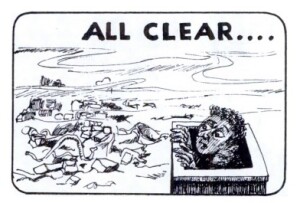 Even though written for kids, the book was candid in its description of the effects of nuclear weapons. For example, “if a 5-megaton bomb (5 million tons of TNT equivalent) were exploded in your living room, everything except specially designed structures in an area extending outward for 3 miles would be totally devastated. Look out your window and think what that means.”
Even though written for kids, the book was candid in its description of the effects of nuclear weapons. For example, “if a 5-megaton bomb (5 million tons of TNT equivalent) were exploded in your living room, everything except specially designed structures in an area extending outward for 3 miles would be totally devastated. Look out your window and think what that means.”
The chapter on home shelters doesn’t go into any detail about construction details. Apparently, that will be left for Mom and Dad to figure out. But it does include this interesting vignette about one student’s experience with a home fallout shelter:
Dan’s eyes were open now. It should be morning, he thought. But it was still pitch black, and stuffy. If it was night, where was his window? The street lamp outside ? And if it was morning, why wasn’t it light ? He sat up on one elbow.
Dan remembered now. He was in the top bunk of the fallout shelter. Jerry was in the bunk below. Their parents had built and stocked the shelter in a corner of their basement; and then they decided to try it out.
What if this were a real attack, Dan wondered. That would be something else. Radiation caused by nuclear explosions would be scary—and could be a danger everywhere for people who survived the blast and heat of the explosion. At least you could protect yourself from radiation and the danger would fade with time. The radiation would decrease rapidly in the first 24 hours, and then start leveling off. Crash ! There was a shattering of glass. The peanut butter jar had fallen off a shelf onto the glass water jug. Both had shattered.
Dan watched his father carefully sweep the glass into the “dry garbage” sack.
“Obviously, no more glass in the shelter,” Dad said. “Plastic bottles for water; and stuff like jelly, and peanut butter, in plastic containers. And it needn’t be beans for breakfast every morning, either. A little planning could provide variety, as well as nourishment. Corned beef hash, canned spaghetti, peaches, and dry cereal . No problem there.”
By ten-thirty, the boys were bored to the teeth . This was the big problem with feeling cramped a close second. His parents were reading. He and Jerry worked awhile on a model jet fighter. But there was no glue. No heater either. No television, no fresh milk, no candles, no kerosene lamps. The radio was on now. This helped relieve the monotony. And he reflected that in a real emergency, the radio would be their link with the outside world. Through radio, they would receive official information and instructions–and they would learn when it would be safe to come out of shelter.
Dan felt sleepy. The air in the shelter was becoming warm and sticky. He longed for the outdoors and sunshine. Kids playing outside the shelter were yelling, having a good time. That made it very hard to wait until evening, when they would be leaving the shelter.
Despite this, he knew that in a real attack situation he would be grateful for the protection from radiation provided by the thick walls and roof of this shelter. He remembered that if there really had been a nuclear explosion, they probably would have to stay in the shelter for at least 24 to 48 hours–or even longer, depending on the outside level of radiation. And, they might even have to dig themselves out. That’s why they needed shovels, axes, and ropes. Dan was glad this was only a trial run. But he was also glad they’d done it.
It would make it easier to cope, if it ever came to the real thing.
Suddenly, it felt good to be alive !
Interestingly, the Civil Defense office also made a series of films designed to accompany the book. The one covering nuclear attack is quite interesting, and I’m sure would have been appreciated by older students. It begins as a “making of” movie about the production of a civil defense film, but has an ironic twist at the end:
Used copies of the book are available on Amazon at this link.
Some links on this site are affiliate links, meaning this site earns a small commission if you make a purchase after clicking the link.

